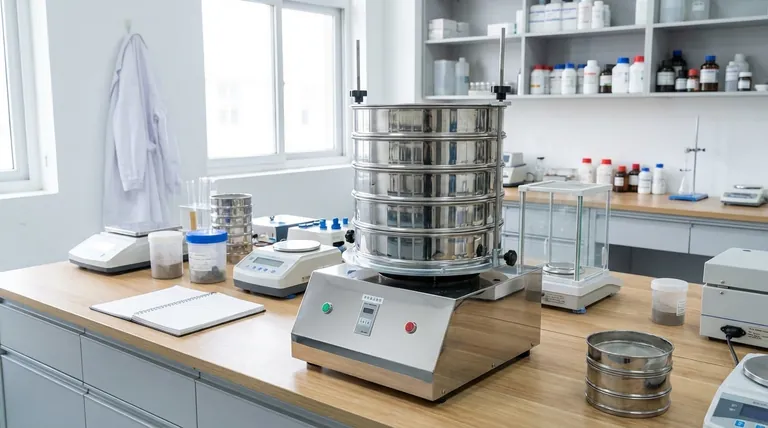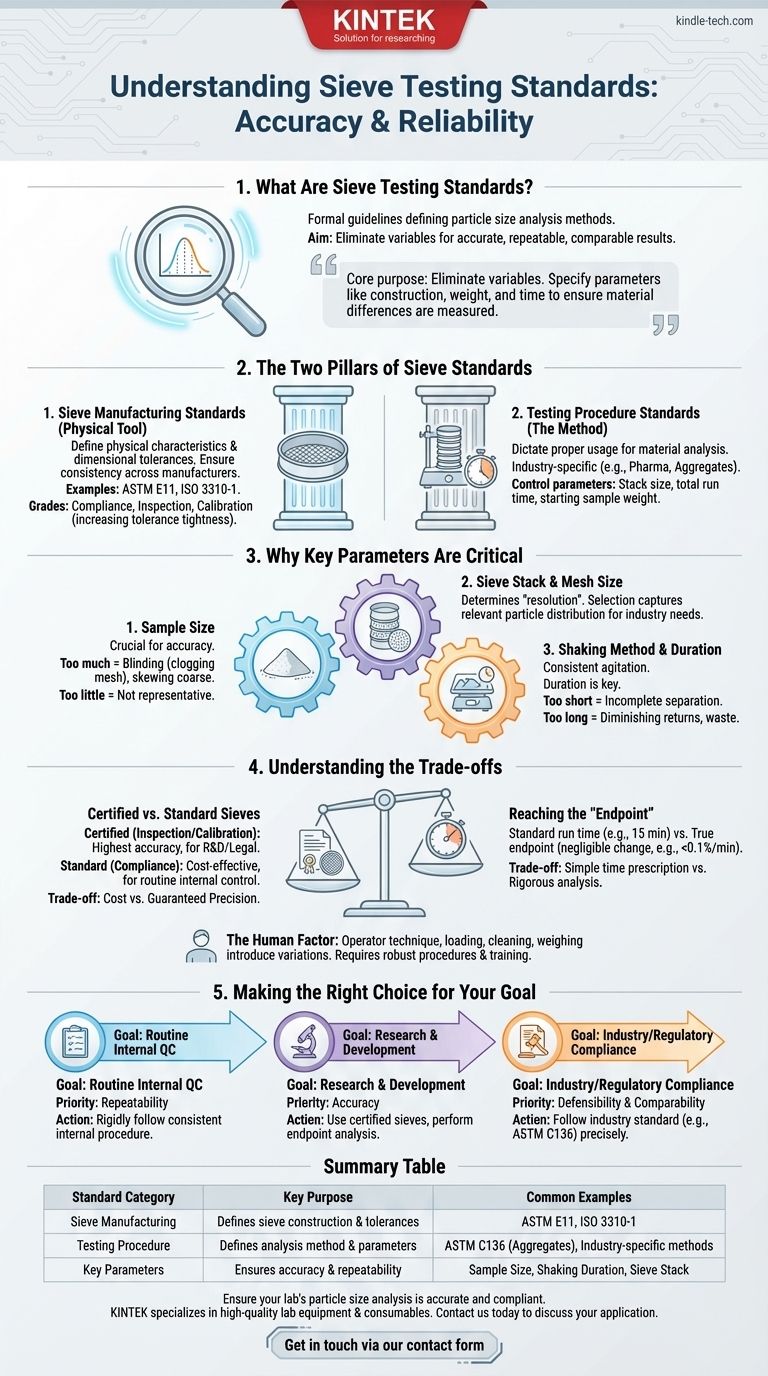In short, sieve testing standards are a set of formal guidelines that define how a particle size analysis must be performed to ensure the results are accurate, repeatable, and comparable across different tests and laboratories. These standards dictate everything from the physical construction of the test sieves themselves to the precise method used to conduct the analysis.
The core purpose of a testing standard is to eliminate variables. By specifying key parameters like sieve construction, sample weight, and shaking time, standards ensure that any difference in results comes from the material itself, not from inconsistent testing methods.

The Two Pillars of Sieve Standards
Sieve testing standards can be divided into two fundamental categories: standards that govern the physical sieve itself and standards that govern the testing procedure. Both are essential for generating trustworthy data.
Standards for Sieve Manufacturing (The Physical Tool)
These standards define the physical characteristics and dimensional tolerances of the test sieve. They ensure that a sieve with a specific mesh number is consistent from one manufacturer to another.
The two dominant global standards for sieve manufacturing are ASTM E11 (American Society for Testing and Materials) and ISO 3310-1 (International Organization for Standardization). These specifications control the wire diameter, the precision of the woven mesh openings, and the frame construction.
Within these standards, sieves can be sold as "Compliance," "Inspection," or "Calibration" grade, each with progressively tighter tolerances and a higher level of statistical verification.
Standards for the Testing Procedure (The Method)
These standards dictate how to properly use the sieves to analyze a material. They are often industry-specific, providing a step-by-step methodology for a particular material type, such as pharmaceuticals, aggregates, or food powders.
Procedural standards control the critical variables of the analysis itself, including the number of sieves in a stack, the total run time on a sieve shaker, and the starting weight of the material sample.
Why Key Parameters Are So Critical
A standard isn't just a list of rules; each parameter is specified to prevent common errors that can invalidate results.
Sample Size
The amount of material you test is crucial. Too much sample material, a condition known as blinding, will clog the mesh openings and prevent smaller particles from passing through, skewing your results toward a coarser distribution. Too little material may not be statistically representative of the entire batch.
Sieve Stack and Mesh Size
The selection of mesh sizes for your sieve stack determines the "resolution" of your analysis. A standard will specify which mesh sizes are needed to capture the particle distribution relevant to your industry's requirements.
Shaking Method and Duration
A sieve shaker is used to create a consistent agitation, ensuring all particles have the opportunity to pass through the appropriate apertures. The standard dictates the required motion (e.g., tapping, orbital) and, critically, the duration of shaking. Insufficient shaking time will result in an incomplete separation, while excessive time yields diminishing returns and wastes resources. The goal is to reach the "endpoint" of the analysis, where the separation is effectively complete.
Understanding the Trade-offs
Adhering to a standard requires balancing precision with practicality. Understanding the inherent trade-offs is key to efficient and effective testing.
Certified Sieves vs. Standard Sieves
Certified sieves (Inspection or Calibration grade) come with documentation verifying that their mesh openings meet the strictest tolerances. This provides the highest level of accuracy and is essential for R&D or when results may be subject to legal or regulatory scrutiny.
For routine internal process control, standard "Compliance" sieves are often sufficient and more cost-effective. The trade-off is cost versus guaranteed precision.
Reaching the "Endpoint"
The procedural standard will specify a run time, such as 15 minutes. This is typically a duration known to be sufficient for most materials. However, for maximum accuracy, the true endpoint is reached when continuing to sieve yields a negligible change in results (e.g., less than 0.1% of the sample passing through a sieve per minute). The trade-off is between following a simple time prescription and performing a more rigorous endpoint analysis.
The Human Factor
Even with perfect equipment and a clear standard, operator technique matters. How a sample is loaded, how sieves are cleaned, and how material is weighed can all introduce small variations. A robust internal procedure and proper training are necessary to minimize this final variable.
Making the Right Choice for Your Goal
Your application determines how you should approach sieve testing standards.
- If your primary focus is routine internal quality control: Your priority is repeatability, so rigidly follow a consistent internal procedure for sample size, stack order, and shaking time.
- If your primary focus is research and development: Your priority is accuracy, so use certified sieves and perform an endpoint analysis to ensure your separation is complete.
- If your primary focus is industry or regulatory compliance: You must follow the specified industry standard (e.g., ASTM C136 for concrete aggregates) to the letter, as your results must be defensible and comparable to external labs.
Ultimately, standards transform sieve analysis from an approximation into a reliable scientific measurement.
Summary Table:
| Standard Category | Key Purpose | Common Examples |
|---|---|---|
| Sieve Manufacturing | Defines sieve construction & tolerances | ASTM E11, ISO 3310-1 |
| Testing Procedure | Defines the analysis method & parameters | ASTM C136 (Aggregates), Industry-specific methods |
| Key Parameters | Ensures accuracy & repeatability | Sample Size, Shaking Duration, Sieve Stack |
Ensure your lab's particle size analysis is accurate and compliant.
KINTEK specializes in high-quality lab equipment and consumables for precise sieve testing. Whether you need certified test sieves for R&D or robust equipment for routine quality control, we provide the reliable tools and expertise to meet your specific standards.
Contact us today to discuss your application and ensure your results are defensible. Get in touch via our contact form to learn more.
Visual Guide

Related Products
- Laboratory Test Sieves and Sieving Machines
- Laboratory Vibratory Sieve Shaker Machine Slap Vibrating Sieve
- Laboratory Sterilizer Lab Autoclave Vertical Pressure Steam Sterilizer for Liquid Crystal Display Automatic Type
- Laboratory Sterilizer Lab Autoclave Pulse Vacuum Lifting Sterilizer
- HFCVD Machine System Equipment for Drawing Die Nano-Diamond Coating
People Also Ask
- What are advantages and disadvantages of sieving method? A Guide to Reliable & Cost-Effective Particle Sizing
- What are the apparatus used for sieve analysis? Build a Reliable Particle Sizing System
- Which equipment is operated for sieves when perform sieving tests? Achieve Accurate Particle Size Analysis
- What are the advantages of the sieve method? Achieve Fast, Reliable Particle Size Analysis
- What range of particle size does the sieve analysis apply? Master the 25 Micron to 1 mm Standard



















